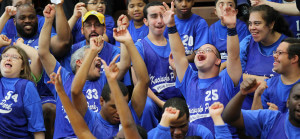
History of the Organization
In the late 1950s, Eunice Kennedy Shriver, disturbed by the attitudes people seemed to have toward those with intellectual disabilities, organized a day camp for children with ID in her back yard. Joined by President John Kennedy, she continued championing the cause through the 1960s and in 1968 the first summer games were held in Chicago. Over 1000 people participated. In 1971 the Olympic Committee gave the organization the right to use the name “Olympics,” and in February of 1977 the first international games were held in Steamboat Springs, Colorado. Today, more than 4.4 million athletes participate at an estimated 80,000 activities worldwide.
What People are Involved
The athletes participating in the Special Olympics are people with intellectual disabilities who learn skills slower than others. These disabilities include: Fragile X syndrome, Down Syndrome, autism spectrum disorders, fetal alcohol syndrome or other disorders including brain injuries or disability from stroke. All of these disabilities impede cognitive functioning and communication, things that are the essence of human interaction.
There are also coaches and mentors, corporate and individual sponsors and celebrity spokespersons involved with the Special Olympics. Various law enforcement agencies have been involved with the organization and its events for more than 33 years. Celebrities involved include Olympic skater Apollo Ono, princess Charlene of Monaco, retired NBA great Dikembe Motumbo and many others. In 2015, the Bank of America sponsored the Flame of Hope, a torch carried coast-to-coast by 10,000 people to raise awareness of intellectual disabilities and to preface the 2015 summer games. More than 7,000 athletes competed in those games assisted by 30,000 volunteers, and there were an estimated 500,000 spectators.
Programs Included in the Olympics
The summer and winter games alternate each year at different venues. There are nearly 30 Olympic-style events in which the athletes compete. In addition to the sporting events, several programs have arisen within the Olympics to serve the athlete community.
- Youth and School Outreach – a curricula available to K-12 schools that teaches acceptance of people with disabilities and inclusion through school programs, one of which is “Get Into It!”
- Unified Sports – program that teaches acceptance and incorporates people with and without disabilities on the playing field.
- Healthy Athletes – an innovative way of providing health and wellness services to the athletes at competitions while giving medical professionals experience in providing services for special needs individuals.
- Youth Leadership – an Olympics sponsored program that teaches young people leadership skills during which they can be on the board of directors, coach or officiate events, and act as spokespersons.
- Family Support – provides a community and support system for families raising special needs children.
From its beginnings as a day camp in Eunice Kennedy Shriver’s back yard to the huge organization it is today, the organization has done much to change the attitudes of people toward the disabled. Despite criticism that holding games specifically for those with handicaps only serves to segregate them further, the group has held true to its goals. The Special Olympics intends to give people with intellectual disabilities the same opportunities for success and self-assurance that people everywhere deserve.
Related Resource: How Can I Get a Jobs With an Olympics Campaign With a Sports Management Degree?